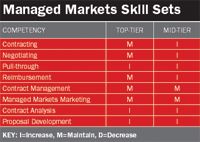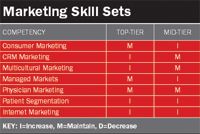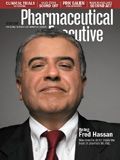What's Worrying Sales?
Pharmaceutical Executive
These are challenging times for senior operations executives who support sales, marketing, and managed markets. The pipeline shortfall, drug-approval delays, and increasing regulatory complexity have squeezed budgets while raising revenue targets. The Medicare Modernization Act (MMA) has caused some of the most far-reaching changes in the sales and marketing landscape, as government purchasing power creates both new opportunities and greater restrictions. In addition, traditional modes of selling have saturated the market, and the sales model the industry knows and loves is no longer so effective.
These are challenging times for senior operations executives who support sales, marketing, and managed markets. The pipeline shortfall, drug-approval delays, and increasing regulatory complexity have squeezed budgets while raising revenue targets. The Medicare Modernization Act (MMA) has caused some of the most far-reaching changes in the sales and marketing landscape, as government purchasing power creates both new opportunities and greater restrictions. In addition, traditional modes of selling have saturated the market, and the sales model the industry knows and loves is no longer so effective.
In this tough new climate, operations executives must ramp up competencies quickly to meet the demand for change, while at the same time, they are under constant pressure to do more with less.

Managed Markets Skill Sets
A bellwether for the industry because of their experience—most average 25 years or more—commercial ops execs are inherently pragmatic. Fortunately for pharma, their on-the-ground perspective is invaluable in dealing with today's pressures—rapid changes in managed markets, reduced effectiveness of traditional sales models, and the resulting challenge to marketing to take a more balanced approach.
To measure this perspective more accurately, we developed a benchmark—a comprehensive dataset of blinded, objective information that shows how companies in similar circumstances are managing these issues; in effect, a sophisticated gap analysis. The benchmark is based on in-depth one-on-one interviews with commercial operations executives at 15 of the top 35 US-based drugmakers, representing $62 billion in revenue. Our goal was to get the execs' take on current challenges and what they most urgently need in order to meet them. We also asked them about their priorities for sales, marketing, and managed markets organizations over the next three years. The execs themselves are responsible for a total of $5.5 billion in total spending and manage 2,500 professionals. Benchmark interviews—which consisted of 40 questions, both quantitative and qualitative—were conducted by senior TGaS Advisors personnel.

Sales Force Skill Sets
Many executives spoke of the coming year as a critical time for innovation. While all cited the need for new models and enhanced competencies, none spoke about areas they could see cut or reduced. But the urgent need for change came through loud and clear, making 2008 a Year of Tough Choices for these seasoned decision makers.

Marketing Skill Sets
Size Matters in Outlook
Several findings were of particular interest. First, executives expressed mixed views about the future, with execs at mid-tier firms far more optimistic about, and confident in, their own company than the industry as a whole. But all share a deep concern for the ongoing viability of information sources, as legislative bodies and professional societies increasingly limit access to prescriber data; some are developing their own proprietary data as a result.
Industry reputation is also key. Respondents agreed that the single-most-important issue to focus on over the next three years is "public perception of the industry." The number-two priority is "managed markets' perception of the industry."
The overall benchmark for confidence in the industry was 62 (all scales are 1 to 100). But we found that executives at top-tier firms (more than $6 billion in annual US sales) and mid-tier firms ($1 to $6 billion in annual US sales) had widely divergent opinions about their own company. Top-tier execs ranked their firms, on average, four points below that benchmark (58 vs. 62), while mid-tier execs were far more hopeful, ranking their company, on average, 17 points above benchmark (79 vs. 62).
We can only speculate about this gap between top- and mid-tier outlooks, but it may be due to the mid-tiers' sense of greater control over making changes and agility in responding to market forces, compared with that of the large multinationals; it may also derive from the built-in optimism required to compete effectively. Top-tier execs, on the other hand, may be warier of the difficult choices ahead and, thus, more cautious in their outlook.
Asked if they would advise people to join the industry, the overall average response was 73. Top-tier executives again were more cautious, weighing in with a 60 average, while mid-tiers' enthusiasm topped out at a 76 aveage.
When it comes to the managed markets, sales, and marketing sectors, top- and mid-tier company executives both expressed great urgency for change and the need for higher-level skills. They also voiced dissatisfaction with the level of integration among these three areas. They feel the areas most in need of change are managed markets (all companies) and sales-force models (particularly top-tier). Increased competencies are needed in a number of areas, especially analytical and business skills. No execs identified areas where competencies or spending could be decreased. While executives place a high value on innovation in commercial operations, our benchmark data show that few have established departments dedicated to this function and its evaluation. The area most in need of increased resources was medical/regulatory/legal review.
How to Manage the Managed Markets?
Managed markets are emerging as a key area for support because of the growing impact of Medicare Part D and specialty-markets reimbursement issues. Despite its importance, the managed markets function in many companies remains fragmented across several departments. On average, only 40 percent of support operations actually reside in the managed markets group, according to information from our own benchmark database.
The commercial-operations benchmark took the pulse of executives regarding the degree of urgency for change. Managed markets ranked highest, at 73, with top-tier at 71 and mid-tier 74.
When evaluating skill sets, mid-tier executives voiced a particular need for contracting, negotiating, and reimbursement skills at both the provider and the payer level (see "Managed Markets Skill Sets"). Top-tiers emphasized the importance of increasing capabilities in pull-through, contract analysis, and proposal development, but seemed satisfied with other skill levels.
The increasing complexity in managed markets, occasioned by MMA and the growth of government's purchasing power, widens the competitive gap between top-tier and mid-tier companies. Big Pharma, with a greater array of product and service options suitable for bundling, appears relatively confident in its ability to compete in managed markets. Smaller companies, on the other hand, see the need to ramp up the skill sets necessary for this new environment.
Desperately Seeking a New Sales Model
While managed markets showed the strongest impetus for change overall, top-tier execs clocked in at a striking 85 average in seeing a need to change the sales force model, while mid-tier execs were considerably more sanguine, averaging 60; the overall industry average was 65. And if the Big Pharma sales force model—large field force, one-on-one personal selling to docs—needs to change, it naturally follows that perceived gaps in operations support for sales would also rank high across the industry, averaging 80, with top-tier execs coming in at 83 and the less pessimisitic mid-tier execs at 79.
These two indices are interrelated; taken together, they reflect the underlying changes now driving pharma. As managed markets and payer purchasing power grow in influence, and as one-on-one physician contact declines in effectiveness, current sales models must shift radically. Operations executives, accustomed to focusing on how best to support field reps with collateral, samples, giveaways, and other staples of traditional selling, are rethinking what's needed to compete.
At the same time, implementing solutions will take two or three years because of the size and complexity of the sales operation. While the more nimble managed markets and marketing functions can move like speedboats or cabin cruisers), the standard analogy of turning around a battleship applies to changing sales forces, which typically number in the thousands. Sales operations will be under tremendous pressure to provide leadership, innovation, and execution here.
Top-tier executives cited the need for sales reps to increase their analytical/business and technology skills, tailored messaging, and customer-service skills (see "Sales Force Skill Sets"). By contrast, mid-tier reps were rated as just fine in analytical and technology areas but as in need of ramping up their knowledge of managed markets and brands and diseases. Respondents also indicated that raising competencies in these areas generally requires more resources for training than mid-tier companies can provide. Our own benchmark data support that conclusion—the average mid-tier sales training budget is $5.6 million, compared with $34.5 million for top-tier companies.
Looking at the divergence between top- and mid-tier in terms of analytical and technology skills, the benchmark corroborates top-tier's recognition that managed markets require better analytics and that changing sales models may call for higher-level tech skills. Mid-tiers, on the other hand, may simply not have the resources to consider ramping up these areas.
The highest need for increased resources in sales support clustered around analytic functions and skills. This correlates with companies' need to do more with less. Thus, functions that help companies perform deeper, more sophisticated customer analysis, collect more targeted information, and develop innovative compensation plans with existing capabilities have the potential to increase revenues.
In some cases, the functions that operations executives want to hold steady on do not require greater knowledge of pharma. Our off-shoring benchmark showed that routine functions, such as standardized reporting and call planning, were, in fact, the most likely commercial operations to be off-shored. About 60 percent of respondents thought it at least somewhat likely that some sales operations would soon be handled overseas.
Innovation and sales training were far and away most in need of more resources, with CRM (customer relationship management) and compliance operations next. POA (plan of action) management and field communications were marked for maintaining at current levels. Pharma companies continually cited innovation, or "doing things differently," as one of the most critical needs in sales operations. The most common forms of innovation cited by large-cap pharma included a tiered sales force model, digital detailing, and CRM. For mid-tier companies, digital detailing, targeting, and call-planning modifications were important, while specialty pharmas cited sales force services, such as reimbursement specialists, and digital detailing as their innovation priorities.
Yet industry efforts to meet this priority are still in draft form. According to our data, only 40 percent of large pharmas (more than 2,500 sales reps) and 20 percent of midsize (500 to 2,500 reps) and specialty companies have established a stand-alone innovation department.
There was general agreement that no one would reduce their reliance on technology in the sales area. Indeed, 70 percent of companies are moving to new technologies in the field in the coming year. Respondents felt that the near-term impact of such technologies as digital detailing and closed-loop promotion, despite the current hype, would be modest at best. Looking to the future, however, the potential impact is high—and as is always the case with new technologies, they must be driven by larger business goals to succeed.
Given that access to customer data is being increasingly restricted in the current climate, commercial operations executives understand they must develop new approaches. Most respondents were less than confident when asked if today's information sources would be equally available tomorrow. Executives gave availability of prescription data only a 42 out of 100 overall in terms of confidence, while anonymous patient-level data (APLD) fared worse, at just 35. Wholesaler and distributor data each earned a 55 overall.
Companies split 60/40 by size when it came to plans for developing new data sources. Top-tier firms have the resources to develop proprietary information for their own competitive advantage. In fact, two execs reported already having taken steps in this direction. By contrast, mid-tiers lack the resources to create their own sources of information.
More than 75 percent of the executives in a 2006 survey told us that they were actively reviewing alternative incentive-compensation strategies based on the declining availability of information in certain geographic territories. More recently, 60 percent of respondents in a related survey said they have actually changed their 2007 programs in the affected areas, further reinforcing the gravity of this issue.
Raising the Marketing Bar
There is a consensus about the urgency for change in the marketing model, with top-tiers averaging 73 and mid-tiers 69—an industry average of 70. In fact, changes are ongoing.
Mid-tier companies expressed the desire to build greater competencies in CRM and multicultural marketing but said they lack the resources to implement (see "Marketing Skill Sets"). And all companies want to increase competencies in patient segmentation and Internet marketing. While some progress has been made industrywide, nearly a third of the pharma brands we recently queried had not established success metrics for their online ad campaigns.
The strongest needs were for functions in support of managed markets from a primary market-research standpoint, business development, and licensing support. Secondary data management and standard reporting, functions of declining value and good candidates for off-shoring, were deemed adequate. Our benchmark data tell us that the average spend in marketing sciences is currently $55 million for top-tier companies and $15 million for mid-tier.
As the industry undergoes increasing scrutiny by regulatory bodies, watchdog groups, and litigators, medical/regulatory/legal review assumes much greater importance. Adding to this, sales force technology innovations are turning a fairly static paper review every six months into a dynamic process that may require more frequent updating. So it is no surprise that operations execs see medical/regulatory/legal review as the most significant area for increased support. In fact, 75 percent felt that this area would undergo the greatest change.
Other high scorers included promotional materials management, which is directly related to the review process, and managed markets support. Additional needs were for innovation and speaker management, while internal and external agency management were at acceptable resource levels.
Investing in Integration
Executives were asked about the degree of integration among sales, marketing, and managed markets. Recognizing that this is an area for significant improvement, they awarded integration only a 53.5.
One of the key aspects promoting integration is coordination of cross-functional departments, particularly with regard to product launches. Benchmark data show that top-tier companies tend to have a distinct group to manage these complex programs. Our data also show that companies are investing in their headquarters' decision-support systems to streamline data processing turnaround times, improve data quality, reduce headcount, enable future flexibility, and improve service levels to sales and marketing. Companies are devoting about 22 people and $7.5 million annually to this effort.
The forces operating in pharma today, including industry-perception issues, cost pressures, regulatory restrictions, increasing government say in pricing, and outdated sales models, strongly impact commercial operations. Executives, who are continually asked to do more with less, understand the need for radical change, yet our benchmark showed no sense of trade-offs. Given a wish list, operations executives identified 24 areas in need of increased resources, 10 for maintaining at present levels and zero (!) for decrease.
This comprehensive benchmark, a wake-up call for the tough choices that must be made, provides a blueprint of the most dynamic areas for future change. This "outside-in" perspective on operations clearly shows that managed markets and sales force models are the top candidates. Armed with this information, executives who support operations have a unique opportunity to make their voices heard and exercise strategic leadership on the road to the future.
Stephen E. Gerard is a managing partner of TGaS Advisors, in East Norriton, PA. He can be reached at 215.646.3884 or sgerard@tgas.com.

The Misinformation Maze: Navigating Public Health in the Digital Age
March 11th 2025Jennifer Butler, chief commercial officer of Pleio, discusses misinformation's threat to public health, where patients are turning for trustworthy health information, the industry's pivot to peer-to-patient strategies to educate patients, and more.
Navigating Distrust: Pharma in the Age of Social Media
February 18th 2025Ian Baer, Founder and CEO of Sooth, discusses how the growing distrust in social media will impact industry marketing strategies and the relationships between pharmaceutical companies and the patients they aim to serve. He also explains dark social, how to combat misinformation, closing the trust gap, and more.